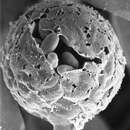pt-BR
nomes no trilho de navegação


Thamnidium elegans is a saprobe: it gets its energy by excreting enzymes to digest dead matter like mouse dung and meat in cold storage.Then the fungus absorbs the digested matter for nutrients.The distribution of Thamnidium elegans has been mostly cosmopolitan.The substrates, Thamnidium elegans has been found on are: tiger dung, horse dung, an orange, bread and a carrot (2).
This species is psychrophilic, meaning an organism that can grow and reproduce in cold conditions.The temperature Thamnidium elegans is the most productive in is 18°C but can still be productive at 1-2°C.The mycelium is heterothallic and is coenocytic in the beginning of its life, but develops irregular septation.The colonies are colorless with gray fruiting heads.The color of the colonies can be seen in Figure 1.
Substrate: Thamnidium elegans can be found in soil, dung of many different animals, and meat in cold storage (13).
For sexual reproduction, T. elegans uses Gametangial Copulation to produce zygospores. Darkly-pigmented zygospores with a rough wall are formed from two mating types of zygophores.They adhere to each other to form a fusion septum.On both sides of the fusion septum, progametangia are formed.Both of the progamtangia divide into a suspensor and a gametangia.The gametangia is located between the two suspensor cells.The cell wall between the two gametangia lysis to allow the nuclei of the two types to merge.Lastly, it forms the zygospore.Figure 2 displays the zygospore life cycle. Thamnidium elegans’s zygospore develops like Mucor and Rhizopus genera.The only difference is that Thamnidium elegans produce zygospores at lower temperatures, about 6°C (13).
As for asexual reproduction it can produce sporangia and/or sporangiola. This species is interesting since it favors sporangia or sporangiola depending on light and temperature.If in low temperature and light conditions, then sporangia formation is favored.The multi-spored sporangia are terminal and have a columella.They release sporangiospores after the sporangial wall disintegrates.The sporangiola branch dichotomously, it branches into two distinct parts, about 4-8 times visualized in Figure 4.Sporangiola can have or lack a columella and usually have 4-5 spores.Sporophores can develop into three different types: 1) just a terminal sporangia, 2) a terminal sporangia with dichotomous lateral branches forming sporangiola, and 3) sporangiola produced on brachlets.These different morphologies are drawn in Figure 3. The sporangiospores are “ovoid to ellipsoid, 3-5 × 5-7.5 μm, hyaline” (5).
Kingdom Fungi
Phylum Mucoromycota
Subphylum Mucromycotina
Class Mucoromycetes
Order Mucorales
Family Mucoraceae
Species Thamnidium elegans
Thamnidium elegans was first documented by Johann Heinrich Friedrich Link, a German Botanist and Naturalist.In 1809, he wrote an article about it in the journal Magazin der Gesellschaft Naturforschenden Freunde Berlin. It is the only species in its genus currently known.The Latin meaning of elegans is elegant.Some synonyms are Mucor elegans (Link, 1827) and Ascophora elegans (Link, 1839).The cDNA of Thamnidium elegans has been sequenced and Scientists found that 6.83% of all fatty acids are γ-linolenic acids so, the scientists deduced the amino acid sequence of delta 6-fatty acid desaturase activity (12).Delta 6-Fatty Acid Desaturase creates a carbon double bond by removing two hydrogen atoms from a fatty acid.It’s an enzyme that is important for maintaining the structure and function of cell membranes by creating double bonds in lower temperatures to make the cell wall more fluid.The enzyme helps the fungus survive in cold temperatures.Another role it plays is synthesis of highly unsaturated fatty acids from linoleic acid (8).
Thamnidium elegans is a saprobic mucoromycete fungus.It likes to grow and reproduce in cold conditions.Commonly found in meat cold storage and dung.The mycelium is white while the fruiting bodies are gray.Sexual reproduction is by zygospores and asexual is sporangia and/or sporangiola (13).The uses for Thamnidium elegans have been for bioabsorption and producing γ-linolenic acid (1,12).
The deliquescent-walled sporangia ofThamnidiumare like those formed byHelicostylum. Persistent-walled sporangia are formed at the apex of dichotomously-branched sporangiophores that arise laterally from the main sporangiophore or its branches. Zygospores have opposed suspensors and a rough, dark zygosporangial wall (Benny, 1992).
Type species:T. elegans
Species ofThamnidium:
T. elegansLink, 1809 (Ges. Naturk. Freunde Berlin Mag. Neuesten Entdeck. Gesammten 3:31).
Hesseltine and Anderson (1956) included four species inThamnidiumand they determined that zygospores ofT. eleganswould form at 7 to 10 C. Mikawa (1979) foundT. elegansin Japan. The type species,T. elegans, is the only species included inThamnidium(Benny, 1992).
Thamnidium elegans je grzib[8], co go ôpisoł Link 1809. Thamnidium elegans nŏleży do zorty Thamnidium i familije Mucoraceae.[9][10] Żŏdne podgatōnki niy sōm wymianowane we Catalogue of Life.[9]
Thamnidium elegans je grzib, co go ôpisoł Link 1809. Thamnidium elegans nŏleży do zorty Thamnidium i familije Mucoraceae. Żŏdne podgatōnki niy sōm wymianowane we Catalogue of Life.